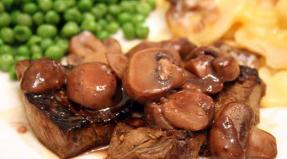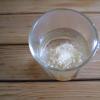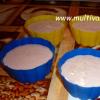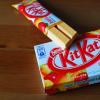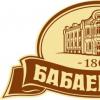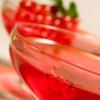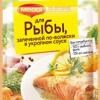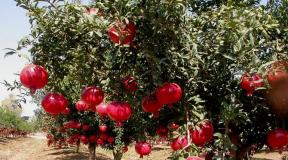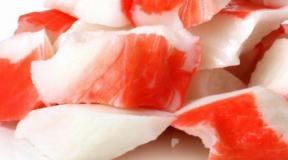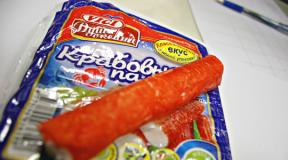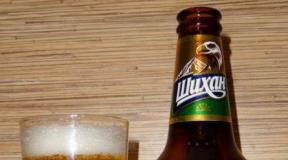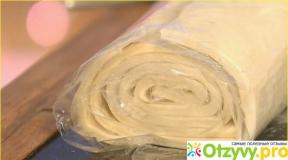Cooking alcoholic sbitn at home. Old Slavic drink sbiten
We often use the name of the ancient Russian drink "sbiten", having a poor idea of how it differs from other traditional Russian drinks. Let's try to figure out what it is and how to cook a real Old Russian sbiten.
Archaeological excavations indicate that there is no people in the world who would not use honey in the preparation of their traditional drinks... The ancients were no exception Slavic peoples... They shared honey with their gods. And drinks with honey and honey-based are an indispensable attribute of all feasts, religious offerings, rituals and everyday life.
Our distant ancestors loved honey drinks and drank them in considerable quantities. This is indirectly confirmed old recipes, in which the ingredients used for their preparation were measured in tens of liters of water and tens of kilograms of honey (for example, take “1.5 pounds of honey”, “dilute with 12 buckets of water”). One of these honey drinks known to us under the name "sbiten".
The first mentions of this ancient Russian drink are found in the chronicles of the 12th century. In those days, sbiten was called "digest", later "broth", "var" (a drink that was obtained by boiling water with the addition of herbs, berries, fruits and honey).
It is assumed that its name comes from the verb "knock down". Whether this is really so is difficult to say. But it is known that two different vessels were usually used in its preparation. One cooked herbal infusion, in the other honey was infused. And before use, the contents of both were mixed - "got confused."
According to the definition given in ancient books and chronicles of the ancient Slavs, sbiten is a sweet honey drink, the main component of which is honey. In addition, water was used for its preparation, different spices, various herbs, including medicinal.
Read also: All about honey sbitn: beneficial features, recipes, composition
How did they drink sbiten in Russia?
Drinking the aromatic and tasty Russian sbiten is a pleasure. AND for a long time(before the emergence and mass distribution of tea), this was perhaps the only hot drink... They drank it at home, cooked it in samovars in knocked down kurens, usually located in the most crowded places of the city. And whiskers at fairs and bazaars carried it in samovars and offered it to the frozen people.
They drank it from samovars, usually from clay circles or special convex cups in a bite with rolls, buns and gingerbread.
There is a version that it was for this drink that the samovar was invented in Russia. Perhaps it is. After all, tea appeared on the table of our ancestors much later.
Honey sbiten with infusion of medicinal herbs(chamomile and mint, St. John's wort and sage) were drunk not only for mood, but also to restore health. In Russia, this popular drink on hot days and in the bath was drunk cold, as a means that perfectly quenches thirst. In winter, in cold weather, it was the best warming and tonic drink.
How to cook Old Russian sbiten?
Most old recipe preparation sbitnya was found in a collection of instructions and advice on all life issues - in the famous book "Domostroy" edition of the 16th century, attributed to Archpriest Sylvester. Although it is known for certain that the Old Russian sbiten appeared much earlier, back in the XI-XIII centuries.
The main ingredients for classic traditional sbitn are honey, water and spices (sage, St. John's wort, ginger, Bay leaf, capsicum, cardamom, cinnamon, mint, cloves).
Sbiten, unlike other traditional honey drinks, is easy and quick to prepare. You can drink it after 3-4 hours. The technology of its preparation does not use a long fermentation process, as, for example, it is done when preparing mead or surya (a little-known ancient Russian drink).
Read also: Sbiten folk consecrated from prostatitis: recipes, indications
According to the method of preparation, sbiten can be non-alcoholic (strength up to 1%) and alcoholic - 4-7%, plain or custard.
Unlike many honey-based drinks, sbiten was most often prepared non-alcoholic. No hops were added to it and no honey was fermented.
There are a lot of recipes for its preparation. The most frequently mentioned sbiten are Stobushinsky, Suzdalsky, Junzhelovy, Vladimirsky, Pikhtovy and Moskovsky. They differ slightly from each other: either by the set of used seasonings and spices, or different technology cooking.
Classic recipe Old Russian sbitnya- This is cooking in two vessels. In one, honey was dissolved in water and brought to a boil, in the other, a decoction of spices was prepared. Then they mixed everything together. And the simplest recipe is to mix all the ingredients at once in one go, boil for 20-30 minutes, insist and strain.
Russian sbitnya recipe
To prepare a real Russian sbitnya according to the recipe from the book of V.V. Pokhlebkin will need:
- Honey - 200 g
- Molasses - 1 kg
- Water - 5-6 l
- Spices: cinnamon - 2 g, cloves - 5 pcs., Star anise - 3 pcs., Ginger - 2 tsp., Black pepper (peas) - 10 pcs., Dry mint - 5 tbsp. l., cardamom - 6-8 pcs.
Cooking method: dissolve honey and molasses in hot water and boil for another quarter of an hour. Add spices and boil everything together for another 10 minutes.

Sbiten is the most useful alternative tea - a drink created to quench thirst and treat various ailments. Alcoholic (4 to 7%) or non-alcoholic, sbiten contains only natural ingredients making it concentrated, knocked down.
Zbiten, as it was also called in the old days, has bright taste with viscous sweet notes of honey and a rich aroma of spices and herbs.
They drink sbiten cold - to cool off in the heat and after the bath, hot - to keep warm and not get sick in the winter cold.
Story
Sbiten was first mentioned in the chronicle of the Eastern Slavs, dating back to 1128, and its first recipe dates back to the 16th century. Sbiten was not a "laughing" drink, it was drunk instead of tea, knocking (combining) the components in a samovar. Alcoholic versions of the drink appeared only in the 18th century, but after the 1917 revolution, it practically ceased to be used. At the end of the 20th century in Russia there were attempts to revive the production of an undeservedly forgotten drink, but it does not experience a renaissance to this day. And in vain - its benefits for the body are endless, and the unthinkable number of recipes allows you to create sbiten for every taste, including at home.
What is sbiten made of?
The required components are pure water and natural honey... Herbs and spices are also part of the drink, but they vary according to their taste.
For example, sage, red pepper, St. John's wort, bay leaves, and ginger powder can be added to sbiten. Undoubtedly, thyme, oregano, mint and lemon balm, strawberry, currant and raspberry leaves will ennoble the taste of the drink and enhance its benefits. Experimenters introduce into the composition fruit and berry juices, including citrus fruits.
Sbiten: benefit
If you break this drink into components, it becomes clear that it is not only an elixir of youth, but also health and longevity.
Due to honey, herbs, spices and fruit and berry fillers, sbiten increases immunity, normalizes blood pressure and glucose levels, strengthens blood vessels and removes toxins. It perfectly fights inflammation in the body and restores strength. In addition, the drink is the best remedy from colds, easily warms or refreshes the body, fortifies it, and also stimulates the reproductive system and relieves prostatitis. After all - it's incredibly tasty!
Sbiten should not be used only by those who are allergic to any of its components.
Differences between sbitnya and mead
Despite the fact that both drinks are based on honey, they have fundamental differences... So, mead is prepared without using yeast, and sbiten is prepared without adding any other alcohol to the composition.
How to store sbiten
A hot drink is not stored; it must be drunk within an hour.
Cold sbiten, which can be reheated later, is stored for up to a year. But keep in mind that you need to store it in glass, placing it in a cool room without access to light.
Attention!
When preparing sbiten yourself, keep in mind that this is enough sweet drink, therefore, if sugar (molasses) is found in recipes, and you are not a big fan of sweets, then reduce its amount, or completely exclude it - honey will already give you the sweetness you need.The second point, which is endlessly argued about, is whether it is possible to heat or boil honey. For centuries, preparing sbiten, people boiled honey, water and spices and were healthy and happy. But if you are against this, then prepare a drink using a different technology, more modern. To do this, all components except honey are brought to a boil, languish for 12-15 minutes, cooled to 40 ° C and mixed with honey. In both cases, the main thing is to enjoy both the process and the finished drink.
Sbiten honey
This is a non-alcoholic version of the drink that can be prepared in 2 ways.

Prepare:
- natural bee honey - 200 gr.
- purified water - 1 liter
- cinnamon (powder) - 1 tsp
- ginger (powder) - 0.5 tsp
- cloves - 2 buds
- anise - 1/3 tsp
- pepper (peas) - 2-5 pieces
- cardamom - 1/3 tsp
You need to cook like this:
In the old days, all the components were combined and after boiling they simmered for another 15-17 minutes. They removed the foam and, after languishing, insisted for another half hour.
Nowadays, many people say that honey does not like heating above 40 ° C. If you think the same way, then you can do this: dissolve honey in a glass of already boiled and cool water, boil herbs and spices in the rest of the water (15 minutes after boiling). Next, cool the broth to 40 ° C and combine with a solution of honey. Hold the resulting sbiten over the fire for several minutes, preventing heating above 40-45 ° C (an induction cooker will help you with this, which can maintain the set temperature).
You need to drink such sbiten hot. His daily use improve health, relieve colds and increase potency.
Sbiten "Russian mulled wine"
This drink contains alcohol, the percentage of which directly depends on the strength of the wine that you take for the recipe.
Prepare:
- red wine (dry) - 1 liter
- cloves - 1-5 buds
- cinnamon - a pinch
- nutmeg- pinch

You need to cook like this:
Dissolve honey in wine, add cloves (to taste), wait until the composition begins to boil, but do not boil it.
Add nutmeg and cinnamon powders to sbiten, remove from heat and, covered with a lid, leave for 20-30 minutes. Strain, heat slightly if necessary and enjoy!
Monastic sbiten
This drink is the oldest and has several options - one of them is intended for storage, the other is for drinking hot, and the third is cold.

A) Monastic sbiten for storage
Prepare:
- natural bee honey - 1 kilo
- strongly brewed tea (green) - 100 ml
- purified water - 3 liters
- fresh hops - 10 gr. (two tsp)
You need to cook like this:
- Dissolve honey with water and bring to a boil. Reduce heat to minimum and simmer liquid for 3 hours 30 minutes, removing white foam.
- Tie the hops into a piece of gauze along with some kind of load (for example, a pre-boiled stone). Dip the bag in honey and simmer for another hour.
- Next, remove the honey liquid from the heat, take out a bag of hops and leave it to ferment in a warm, dark place.
- When the wort ferments, you need to pour freshly brewed strong, but cooled tea into it, strain and pour into sterile bottles.
They store this sbiten in a cellar or basement - where it is cool and there is no light. Best taste the drink acquires after 6-8 months of storage.
B) Monastic sbiten hot
Prepare:
- natural bee honey - 150 gr.
- molasses or sugar - 100 gr.
- purified water - 2 liters
- lemon - 0.5 pieces
- ginger (powder) - 1/4 tsp
- cinnamon (powder) - 1 tsp
- pepper (peas) - 2-6 pieces
- cloves - 2 buds
- cardamom - 1/2 tsp
- thyme - 1/2 tsp
- mint (leaves) - 2 tsp
- St. John's wort (dry) - 3 tsp
You need to cook like this:
- Dissolve honey and sugar in ¼ part of water, wait until it boils, removing the foam cap during cooking, and simmer for 15 minutes over low heat.
- Put spices and herbs in the remaining water, bring to a boil and simmer with low heat for about 18-20 minutes. Next, remove from heat and insist for another 15 minutes.
- We pass both liquids through cheesecloth folded in 2-3 layers and combine.
- Warm up the resulting sbiten for a couple of minutes, but do not let it boil.
You should drink this elixir of longevity only hot.
C) Monastic sbiten cold
Prepare:
- natural bee honey - 250 gr.
- water - 1 liter
- hops - 5 gr. (1 tsp)
- spices and herbs (cinnamon, cloves, pepper, cardamom, lavrushka, mint) - pinch at a time (to taste and desire)
You need to cook like this:
- Bring water to a boil and dissolve honey in it and add spices.
- We simmer the composition at low heat, not letting it boil for about 3 hours, remove from heat, cool and filter.
Drinking such sbiten is cold. It is incomparable in the heat and after the bath.
Prepare:
- natural bee honey - 4 tablespoons
- cranberries - 1 glass
- purified water - 0.8 - 0.9 liters
- cloves - 2 buds
- cinnamon (in sticks) - 1 pc.
- nutmeg - a pinch

You need to cook like this:
- Squeeze the juice from the cranberries.
- Mix the pomace with spices and fill it with water, wait for it to boil. Next, the composition must be darkened for 13-15 minutes at low heat, cooled slightly (up to 40 ° C) and filtered.
- Dissolve honey in the broth and insist overnight (4-5 hours) in the refrigerator.
- Before drinking, cranberry sbiten is added to it Fresh Juice cranberries and, if desired, heated (no higher than 40 ° C).
This drink can be prepared even easier - just place all the ingredients in a blender bowl, beat and let it brew for a couple of hours. Next, the sbiten must be filtered and, if desired, heated to 40 ° C.
In addition, sbiten according to this recipe (regardless of the preparation method) easily turns into alcoholic - just pour into ready drink 200 ml of red wine or 100 ml strong alcohol, for example, rum or cognac.
Many peoples have national recipes hot low-alcohol drinks served for warming in the cold season. The Slavic answer to grog and mulled wine is honey sbiten, which is much more useful than its "overseas" counterparts. Cooking sbitn at home does not require rare ingredients and does not take much time. The proposed alcoholic and non-alcoholic recipes can be handled by chefs of any skill.
Sbiten Is an old Slavic drink made of water, honey, spices and other ingredients. Differs in a pronounced honey flavor with the aroma of herbs, has an anti-inflammatory and warming effect. It can be alcoholic and non-alcoholic, served both hot and cold. Sbiten tastes like mead, but it is prepared using a simpler and faster technology.
In the Slavic chronicles, the first memory of sbitn dates back to 1128. In many regions, this drink was also called "digest", "vzvar" and "var". In addition to honey, St. John's wort, ginger, bay leaf and sage were added to the composition. After 1917, the popularity of sbiten declined sharply, recent attempts to improve industrial production were unsuccessful, demand was very low.
Alcoholic sbiten
Ingredients:
- dry red wine - 1 l;
- honey - 150 g;
- cinnamon, cloves, nutmeg - to taste.
Preparation:
1. Mix wine and honey.
2. Boil the mixture over low heat, removing the foam.
3. Remove the pan from heat, add spices, cover, leave for 25-30 minutes.
4. Before use, strain through cheesecloth and heat until the right temperature.

Non-alcoholic sbiten with ginger
Ingredients:
- ginger root - 3 cm;
- cinnamon - 1 stick;
- sugar - 6 tablespoons;
- honey - 5 tablespoons;
- water - 1 l.
Preparation:
1. Peel and finely chop the ginger root.
2. Boil water, add cinnamon, cloves and ginger.
3. Add sugar and honey, simmer for 8-10 minutes, skimming off the foam.
4. Turn off the heat and let the drink brew for 25-30 minutes.
5. Strain through cheesecloth.
 With ginger
With ginger This version of Russian sbitnya can be served hot or cold. Heat (cool) to the desired temperature before use. Another non-alcoholic recipe presented in the video.
The benefits of homemade sbit:
- strengthens the immune system;
- contains vitamins of groups B and C;
- is the prevention of infectious, respiratory and colds;
- reduces inflammation;
- helps with diseases of the gums and oral cavity;
- kills pathogenic microorganisms.
The benefits of sbitn are due to the ingredients that make up it. List useful actions sbitnya is wide: from the prevention of diseases to their immediate cure. Using various ingredients as part of sbitnya, you can achieve both a tonic and, conversely, a calming effect. If infusions of herbs are used in sbitna, then they help prevent colds, improve digestion and metabolism, have a positive effect on the activity of the brain, stimulate the activity of the cardiovascular system. If elecampane is added to the composition of sbitnya, the drink will have a pronounced anti-cold effect. When using herbs such as thyme, sage and some others, the drink acquires anti-inflammatory properties. And sbiten with ginger and ivan tea perfectly relieves a hangover. Cloves in sbitn have a beneficial effect on digestion, cinnamon has a hypoglycemic effect, and cardamom is known for its calming effect.
But the main beneficial properties of sbitn are from the honey that is part of it. Honey enriches sbiten with vitamins and microelements (iron, calcium, iodine, magnesium, potassium).
Sbitn also has contraindications. This drink should not be consumed by persons suffering from allergic diseases. Persons with chronic diseases liver, kidney, heart, people suffering diabetes mellitus, it is necessary to consult with a specialist regarding the possibility of using sbitnya.
Can be added to sbiten, along with spices, sliced lemon. This makes the drink a real storehouse of vitamin C.
For sbitn, a special extract of the needles of coniferous plants is brewed, you can find this in taiga farms. You can add raspberries, sea buckthorn, Linden blossom, cardamom, chamomile, oranges, ginger and lemon.
Sbiten is drunk warm and fresh - it is considered that if the sbiten has stood for more than half an hour, it has lost its useful properties.
Ancient Russian cuisine is rich and varied; it includes many original dishes and drinks. Many are now, unfortunately, forgotten. Among the undeservedly forgotten drinks there is also sbiten, once beloved and appreciated in Russia.
It was very widespread in the 18th - 19th centuries. By this time, tea and coffee had been ousted from wealthy houses, but for the common people it remained the most favorite drink. After the 1917 revolution, sbiten almost fell out of use. And only in the 90s. last century, sbitn was remembered and attempts to revive it began.
The history of the origin of sbitnya in Russia

(Sbiter - old postcard)
Sbiten is a hot drink indispensable in the cold Russian climate. It was made in rich houses and in the poor, served in taverns and sold on the street. On the streets walked knockers with huge vessels, like samovars, wrapped in warm cloth on their backs. V winter period it was The best way keep warm on the street.
The profession of a knocker was popular in Russia, especially in places of mass gathering of people, at fairs, folk festivals, etc. Moreover, the popular all year round, because sbiten can be drunk cold.
Vessels for sbitn were made of copper, they were called sakla or baklag. These containers later served as a prototype for the creation of a samovar for tea.

By the way, when exactly sbiten appeared in Russia, no one knows for sure. Perhaps at least 1000 years ago. It is reliably known that in many early works of Old Russian writing, he is mentioned, for example, in the chronicles of the 12th century. the description of the sbit is already there. In Domostroy XVI century. among many instructions and recipes there is also a recipe for sbitnya.
Foreigners who visited Russia at the beginning of the 18th century described this drink with enthusiasm. And they even compared it with mulled wine, apparently because in the taverns in which they drank it, sbiten was made on the basis of wine. But usually they didn't make sbiten with wine; other ingredients were included in its recipe.
The origin of the word "Sbiten"
It is believed that the drink was originally called a brew, digest, or simply var. He received the name "sbiten" later.
Sbiten is prepared in two containers, honey was infused in one, spices in the other. Then the contents of both containers were mixed - knocked down. Perhaps this is the origin of the name.
But it should be noted that the word "broth" did not go out of use either.
How sbiten was prepared in Russia

There are a great many recipes for preparing this drink, they differ in both the preparation method and the components. To begin with, it should be noted that it is prepared on the basis of water, honey (instead of honey, they could have taken molasses) and spices. These are the main ingredients. Everything else can be varied. For example, in addition to spices, various herbal preparations are added.
Sbiten can be divided into two types according to the method of preparation: simple sbiten and custard. When preparing choux sbitn, a wort is made from honey (or molasses), to which are added various seasonings... The wort can ferment for up to two weeks, and in this case it already turns out low alcohol drink like mash, beer or honey.
What sbiten drinks well with
Sbiten is drunk as well as tea. But it's already sweet, so unsweetened ones are best. bakery products: bagels, drying, pretzels, bagels, rolls. Of course, sweet lovers can also take gingerbread.

